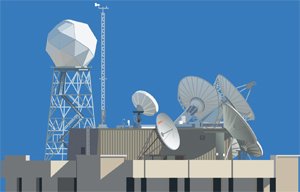Increasing Lead Times for Hazardous Weather Warnings
UW-Madison researchers Ralph Petersen, Jason Otkin, and Jun Li of CIMSS, along with Tim Schmitt and Brad Pierce of the Advanced Satellite Products Branch (ASPB) participated in the Regional Observing System Simulation Experiments (OSSE) workshop and the High-Impact-Weather/Warn-On-Forecast workshop held 07-09 February 2012 in Norman, OK.
Warn-on-Forecast is a National Oceanic and Atmospheric Administration (NOAA) research program tasked to increase tornado, severe thunderstorm, and flash flood warning lead times. A primary strategic goal for NOAA is increasing the lead-time and accuracy for hazardous weather and water warnings and forecasts, in order to reduce loss of life, injury, and damage to the economy.
![]()
Left: An ensemble of storm-scale NWP models predicts the path of a potentially tornadic supercell during the next hour. The ensemble is used to create probabilistic tornado guidance.
Right: Probabilistic tornado guidance: Forecast look on track, storm circulation (hook echo) is tracking along centerline of highest tornadic probabilities.
Image courtesy of NOAA National Severe Storms Laboratory
Oral presentations were given by the CIMSS/ASPB representatives on topics ranging from the need and generation of regional OSSEs, status of air quality OSSEs, Numerical Weather Prediction (NWP) opportunities for the Advanced Baseline Imager (ABI) and recent progress on assimilating satellite data for high-impact weather forecasting.
Back to Front Page

